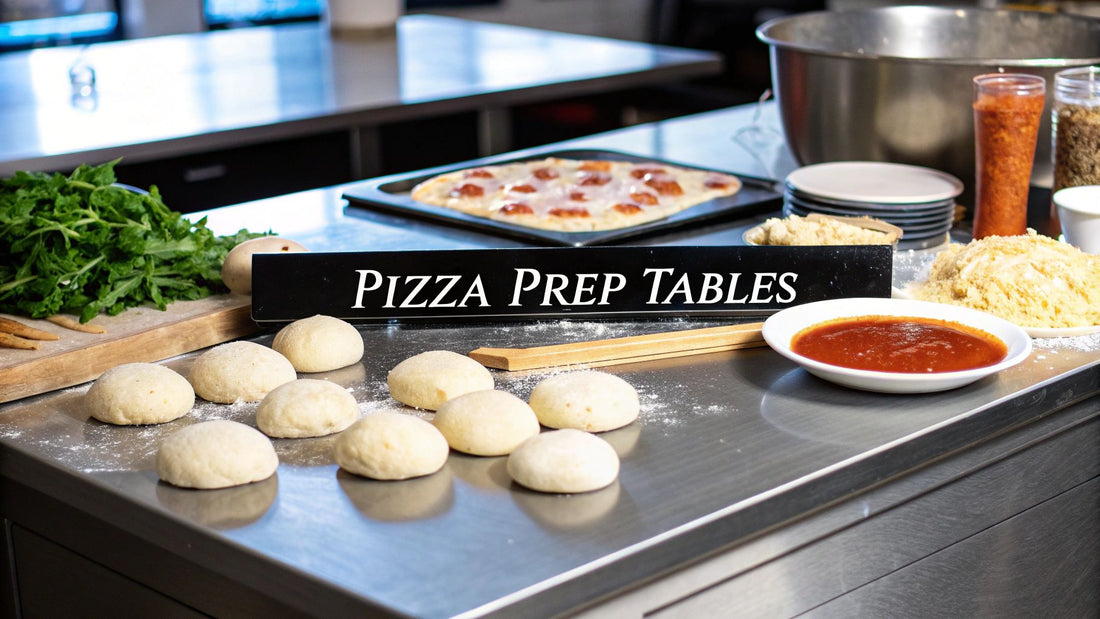
Choosing Commercial Stainless Steel Tables for Pizzerias
Share
In a pizzeria, the right commercial stainless steel table isn't just a surface—it's the command center. This is where speed, hygiene, and consistency are born. Think of this essential piece of equipment as the primary canvas for every pizza you create, a role that demands unmatched durability and food safety.
The Foundation of Every Great Pizza Kitchen
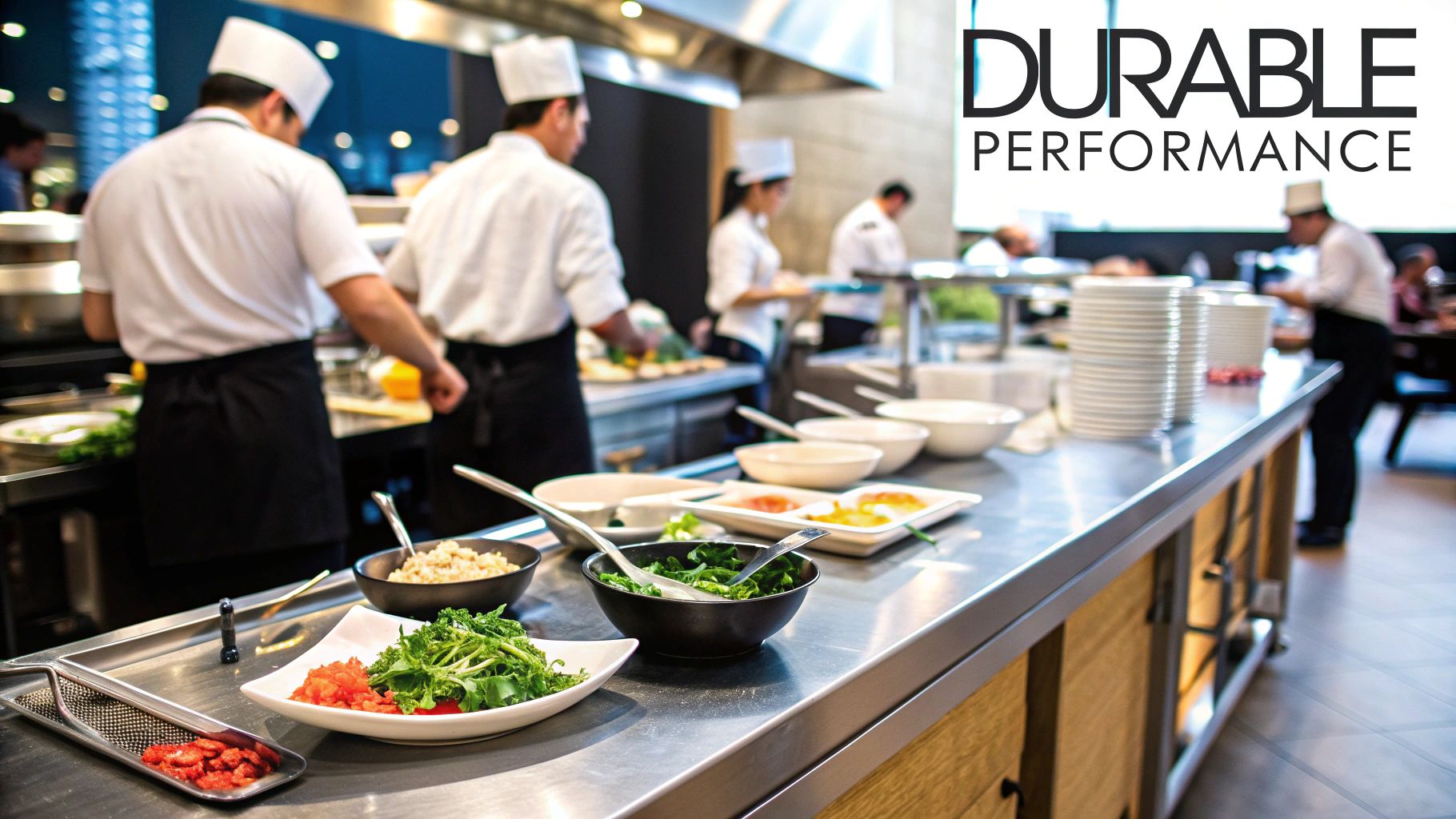
Imagine your pizza prep table as an artist's workbench. It’s the spot where raw materials—dough, sauce, cheese, and toppings—are transformed into a finished masterpiece. Just like an artist needs a sturdy, reliable surface that won’t interfere with their work, a pizza maker needs a table that can handle the unique pressures of a high-volume pizzeria.
And the demands are intense. You've got constant dough work, from kneading to stretching, which requires a perfectly smooth, non-porous surface that won't harbor bacteria or absorb oils. This is exactly where other materials like wood and plastic just can't keep up. Wood is porous, making it a nightmare to sanitize properly, and it's prone to soaking up moisture and odors. Plastic, on the other hand, scratches easily from pizza cutters and dough scrapers, creating tiny crevices where bacteria can hide and thrive.
Why Material Choice Is Critical for Pizza Prep
In a bustling pizzeria, the prep station is a whirlwind of activity. Flour dusts the air, acidic tomato sauce splatters, and heavy dough trays are constantly being slammed down. A commercial stainless steel table is engineered from the ground up to handle this controlled chaos.
- Hygiene and Food Safety: Stainless steel is non-porous. That’s a game-changer for cleaning and sanitizing, which is critical for passing health inspections and preventing cross-contamination between different pizzas.
- Durability Against Wear: It easily resists corrosion from acidic ingredients like tomato sauce and vinegar. Plus, it won't get chewed up by the sharp edges of pizza cutters or dough scrapers.
- Heat Resistance: The surface can take the heat from a fresh-out-of-the-oven pizza pan placed on it for a moment—a common occurrence during a busy service.
The quality and design of your pizza prep table directly influence your kitchen's workflow efficiency and the consistency of every pizza you serve. It's not just furniture; it's a fundamental tool for production.
Investing in Operational Success
Choosing the right commercial stainless steel table is a foundational investment in your pizzeria's success. A well-designed table streamlines the entire pizza-making process, letting your staff work faster and more efficiently. That translates directly to quicker ticket times, happier customers, and a much smoother-running kitchen.
A high-quality table is also a long-term asset. When you're planning the budget for these essential pieces, it's smart to look into options like equipment financing for your small business to see what’s possible. By prioritizing a durable, compliant, and functional pizza prep station from day one, you're setting the stage for operational excellence and building your pizzeria on a solid, safe foundation.
Understanding Steel Grades and NSF Certification for Pizza Tables
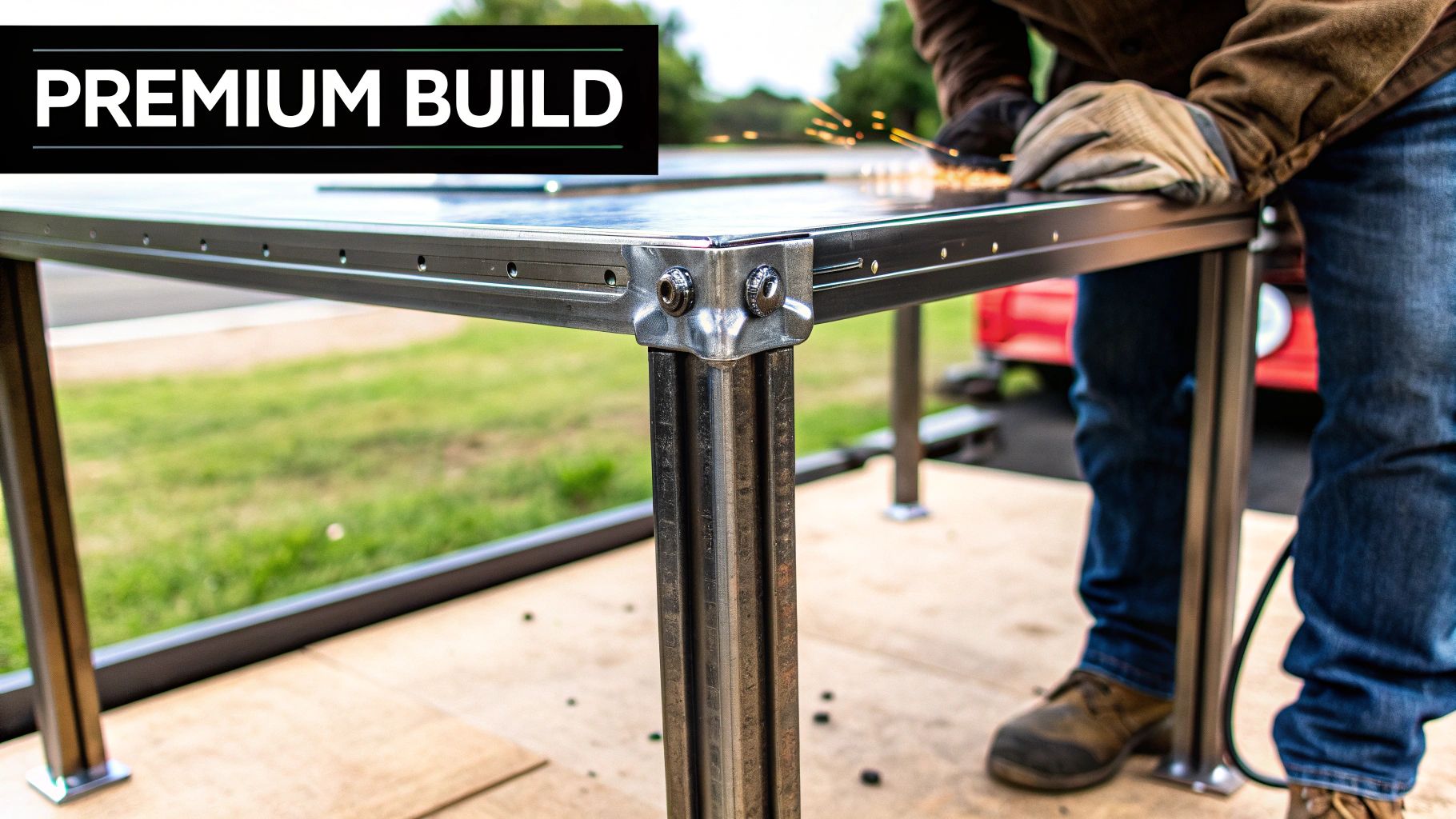
Picture this: it’s Friday night, your pizzeria is packed, and your prep table takes a beating from sauce splatters, cheese shavings, and the constant friction of dough work. Those grade numbers—304, 430—aren’t just alphabet soup. They tell a story about how long your pizza prep table will look sharp and stay rust-free under the real-world pressure of a busy kitchen.
Stainless steel comes in different “flavors,” each designed for a specific task in a pizzeria. Some alloys shrug off corrosion like a champ, while others are better suited for equipment stands. Knowing which grade does what helps you invest once and enjoy hassle-free service for years.
The Critical Difference Between 304 And 430 Steel
When you compare 304 vs. 430, it’s like choosing between your star pizza maker and a utility player. One is versatile and reliable in every position; the other excels at support roles but flags under the nonstop action of the main prep line.
| Grade | Magnetic | Corrosion Resistance | Ideal Pizzeria Application |
|---|---|---|---|
| 430 | Yes | Moderate | Equipment stands, side panels |
| 304 | No | High | Pizza prep tops, dough troughs |
- 430 Stainless Steel: A solid choice for non-food contact areas. It’s magnetic, resists basic wear, and suits areas away from acidic sauces and constant moisture.
- 304 Stainless Steel: The heavyweight champion for food prep. Thanks to added nickel, it laughs at tomato acids, briny toppings, and harsh cleaning chemicals.
For a pizza prep table—where marinara and mozzarella meet daily—304 grade is non-negotiable. Skimp on quality for your main work surface, and you’ll face pitting, rust spots, and costly replacements. Choose 304, and you’ll get a table that withstands the rigors of pizza making for years.
Decoding NSF Certification
Once you’ve locked in 304 steel, your next stop is the NSF badge. The National Sanitation Foundation doesn’t hand out stickers lightly—they test design, material, and cleanability to the letter, ensuring it's safe for food service.
“An NSF-certified table isn’t just a piece of equipment—it’s proof you’ve thought through every crack and corner where bacteria from raw toppings could lurk.”
This certification means:
- Surfaces are smooth and free of crevices where flour and food particles can get trapped.
- Joints and welds stand up to intense scrubbing required in a pizzeria.
- Materials won’t leach harmful substances into your dough or ingredients.
On top of that, market data shows some NSF-certified tables moving over 550 units monthly on single platforms. That figure underscores one simple truth: pizzeria operators everywhere insist on compliance for safety and durability. To dig deeper into sales trends, read the hot-selling commercial stainless steel table market.
By mastering these two essentials—steel grade and NSF approval—you’ll shop with confidence. You’ll know which specs matter, avoid shortcuts, and pick a pizza prep table that combines lasting strength with hassle-free sanitation. For more on choosing the right setup, explore our guide on selecting a food prep table for your needs.
Finding the Perfect Pizza Prep Table Configuration
Picking the right commercial stainless steel table for your pizzeria goes way beyond just choosing a size. You’re actually building the command center for your entire pizza production line. The perfect setup supports your kitchen's natural rhythm, turning what could be chaos into a smooth, efficient flow from dough to oven. A generic table just won't cut it—your choice has to match your specific pizza-making workflow.
This means you need to think through every detail, from how you’ll store a 50-pound bag of flour to how you'll keep stray toppings from hitting the floor during a frantic rush. The right features will save your team precious seconds on every single order, and that adds up to huge gains in speed and consistency over a busy night.
Matching Table Base to Pizzeria Needs
The foundation of your prep station—the base—plays a massive role in organization and how you use your space. There's no one-size-fits-all answer here; the best choice depends entirely on what you need to keep within arm's reach for making pizzas. An open-concept pizzeria with a giant walk-in pantry has different needs than a cramped city spot where every square inch is prime real estate.
Think about these common setups for your pizza prep area:
- Open Base Tables: These give you maximum flexibility. That open space underneath is perfect for sliding in big, mobile ingredient bins—think a huge container of cornmeal for dusting peels or that giant sack of flour. This design is your best bet if you use bulky items and need to move them around.
- Tables with Undershelves: For organized storage of more standardized items, an undershelf is a lifesaver. It’s the perfect home for stacking dough trays, sheet pans, and backup containers of shredded cheese or pre-sliced pepperoni. An adjustable undershelf is even better, letting you customize the height to perfectly fit your specific gear.
- Enclosed Base or Cabinet Tables: If you need to keep things protected from the daily storm of flour and dust, a cabinet base is the way to go. These are fantastic for storing specialty ingredients, extra pizza screens, or cleaning supplies, keeping your kitchen looking sharp and organized.
Sizing Your Station for a Seamless Workflow
Getting the size right is absolutely critical for an ergonomic and efficient pizzeria. A table that’s too small will create a cramped, frustrating workspace that slows everyone down. One that's too big can mess up the flow of traffic and create wasted steps. Your goal is to create a seamless path from the dough mixer to the prep station and finally to the pizza oven.
Before you even think about buying, grab a tape measure and map out your space. Make sure there's enough room for your crew to move around the table without bumping into each other or other equipment, especially during peak hours. A minimum of 36 inches of clearance is a solid rule of thumb for walkways in any commercial kitchen.
This graphic shows how three common table sizes stack up and how they’ll impact your floor plan.
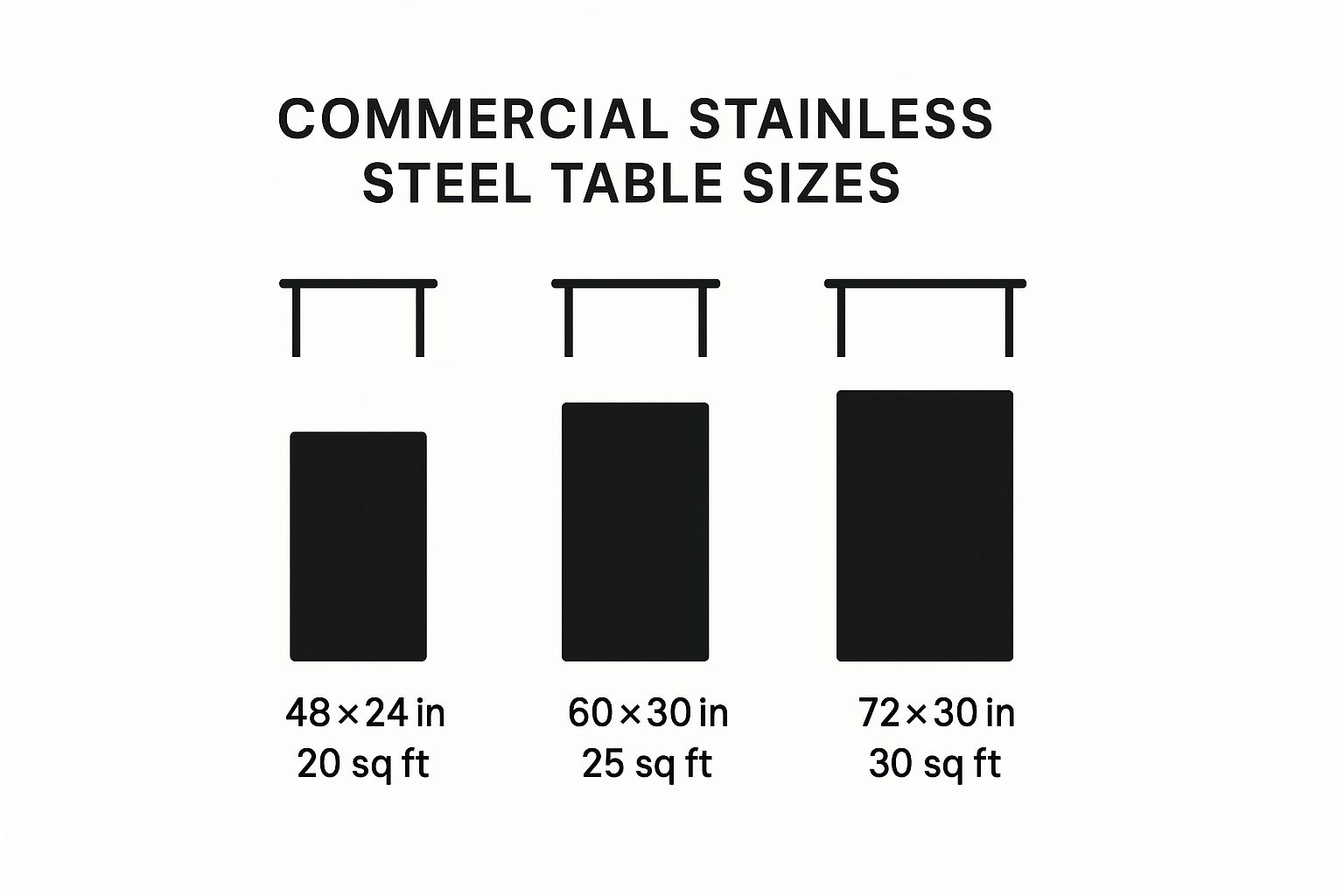
As you can see, jumping from a 60-inch to a 72-inch table only adds five square feet to the footprint, but it gives you a massive 20% increase in valuable workspace. That's a huge return for a small change in layout.
Essential Add-Ons for Pizzeria Efficiency
Beyond the basic table, a few key add-ons can dramatically improve how your commercial stainless steel tables function in a pizza-making environment. These small details are what separate a decent prep station from a truly great one.
A well-chosen accessory isn't a luxury; it's a strategic tool for managing mess, improving mobility, and boosting overall productivity in a high-speed pizzeria environment.
Here are some of the most valuable add-ons to consider:
- Backsplashes: If your table is going against a wall, an integrated backsplash is a non-negotiable. It stops flour, sauce, and water from splashing all over the wall, making cleanup way faster and keeping your kitchen more hygienic.
- Locking Casters: Wheels, or casters, give you incredible flexibility. They let you easily roll the table out of the way for deep cleaning or to reconfigure your kitchen on the fly. Always, always opt for locking casters to make sure the table stays put and is rock-solid during vigorous dough prep.
- Marine Edges: This feature is just a raised edge around the tabletop, but for a pizzeria, it's a total game-changer. A marine edge is brilliant for containing stray flour, cornmeal, and toppings, which keeps your floors cleaner and cuts down on food waste.
Pizza Prep Table Feature Comparison
To help you decide, here’s a quick breakdown of the essential features and how they benefit a real-world pizzeria operation.
| Feature | Benefit for Pizza Restaurants | Best For |
|---|---|---|
| Open Base | Allows for storage of large, mobile ingredient bins like flour or dough mixers. | Kitchens that use bulky ingredients and need maximum flexibility. |
| Undershelf | Provides organized, accessible storage for dough trays, pans, and backup toppings. | Pizzerias that need structured storage for standardized containers. |
| Cabinet Base | Protects specialty ingredients or supplies from dust and debris, keeping the area tidy. | Operations needing secure, enclosed storage for sensitive items. |
| Backsplash | Prevents splashes on walls, simplifying cleanup and improving overall kitchen hygiene. | Any table placed against a wall. |
| Locking Casters | Offers mobility for cleaning and layout changes while ensuring stability during use. | Dynamic kitchens that require frequent reconfiguration or deep cleaning. |
| Marine Edge | Contains stray flour, toppings, and liquids on the tabletop, reducing floor mess and waste. | High-volume pizzerias where containing mess is a constant battle. |
Thinking through these options helps you move beyond a simple table and design a true pizza workstation.
By carefully considering your base style, exact dimensions, and these value-adding features, you can build a pizza prep station that works for you, not against you. For a closer look at a popular and versatile size, check out our analysis of the 67-inch pizza prep table. This tailored approach is how you ensure your investment directly supports a faster, cleaner, and more profitable pizzeria.
Getting the Most Out of Your Pizzeria Kitchen Workflow
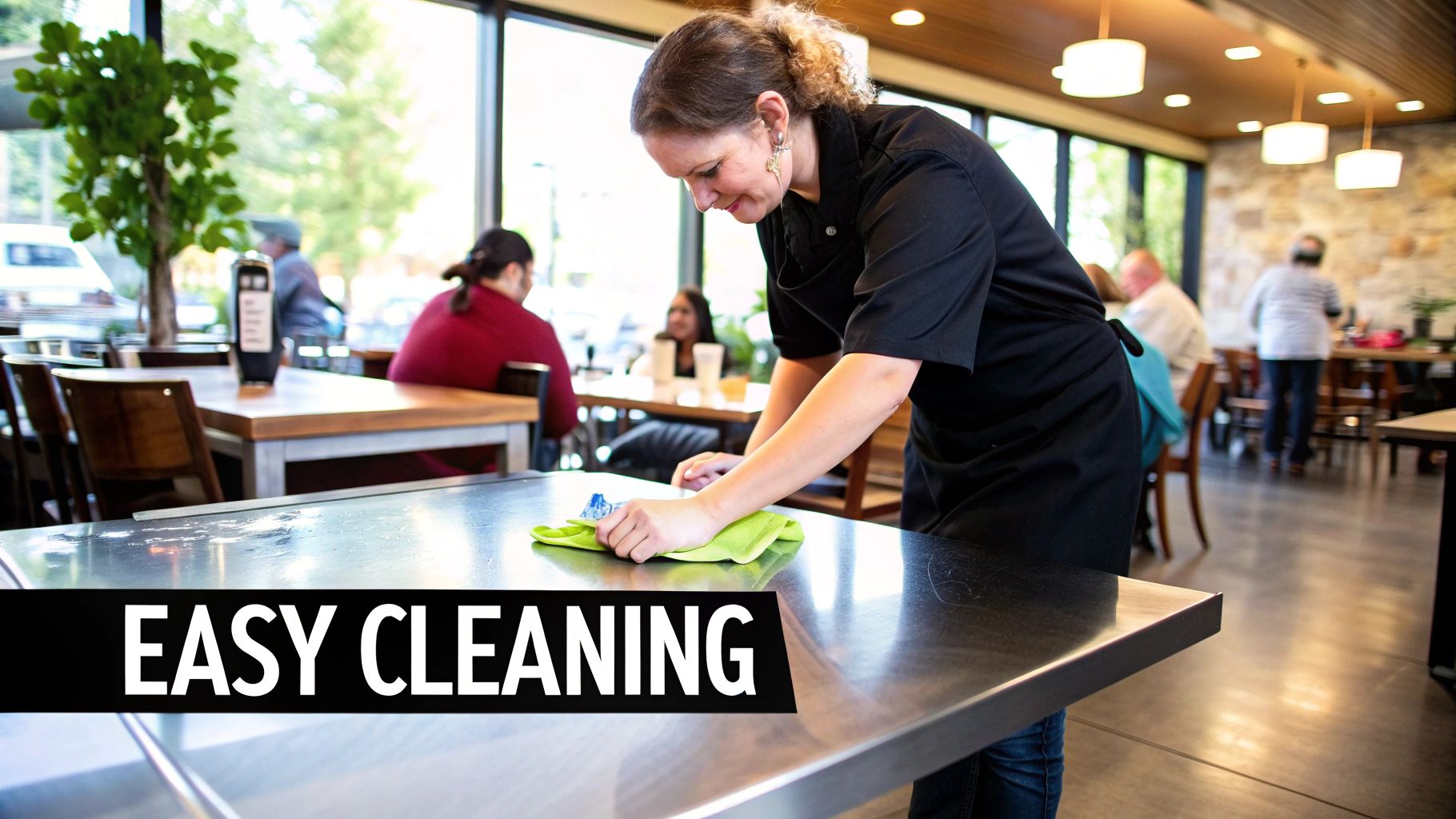
A top-tier commercial stainless steel table is more than just a place to build pizzas; its real value shines when you weave it into the very rhythm of your kitchen. The goal here is to turn that slab of steel into the beating heart of your pizzeria—a station built for speed, consistency, and keeping your crew happy.
This is where the classic culinary principle of 'Mise en Place' gets its pizza-making makeover.
Mise en Place, French for "everything in its place," is the secret weapon of every high-volume kitchen. For a pizzeria, this means having your toppings, cheese, sauces, and dough all organized around the prep table to create a smooth, almost unconscious assembly line. When it’s done right, your team can build pizzas with barely a wasted motion, shaving precious seconds off every single order.
Designing Your Pizza Assembly Line
Think of your prep station like a pilot's cockpit. Every critical control is within immediate reach, allowing for instant reaction. Your pizza makers need that same advantage—every ingredient and tool must be positioned to cut out wasted steps and frantic searching.
A logical flow is everything. Start with your dough at one end of the table, then the sauce station, followed by cheese, and finally, a neatly organized spread of toppings. This straight-line process guides the pizza from start to finish, preventing traffic jams and confusion when the dinner rush hits hard.
It’s this demand for smart, adaptable setups that’s driving the market for versatile kitchen gear. The global market for commercial stainless steel tables was valued at around USD 1.2 billion and is expected to hit USD 1.8 billion by 2033. This growth shows just how critical these durable, customizable surfaces have become for modern pizzerias. You can dig deeper into these market trends in this detailed industry report.
Creating a "Golden Triangle" for Pizzerias
Beyond just organizing the table itself, where you put it in the kitchen is just as important. The most efficient pizzerias live by the "golden triangle" of workflow, creating a tight loop between three key spots: refrigeration, the prep table, and the pizza oven.
The best kitchen layouts are all about minimizing the steps a chef takes between storing, preparing, and cooking. Every step saved is a direct win for your production capacity, especially when you're slammed.
Your commercial stainless steel table needs to be right in the middle of this triangle. Your staff should be able to pivot—not walk—to grab dough from the fridge, build the pizza on the table, and slide it into the oven.
Here are a few layout tips to max out your pizzeria's efficiency:
- Refrigeration Access: Keep your refrigerated prep table or a low-boy fridge right under or next to your main work surface. This keeps toppings and cheese perfectly chilled and literally an arm's length away.
- Dough Station Proximity: If you use a separate dough sheeter or press, put it at the very beginning of your assembly line. This lets you feed perfectly prepped dough bases right onto the prep surface without missing a beat.
- Clear Path to the Oven: Make sure there’s a straight, uncluttered path from the end of the prep table to the mouth of the oven. This simple step prevents spills, accidents, and slowdowns when moving from prep to cook.
By carefully planning your station, you can seriously boost your output and cut down on staff fatigue. To learn more about getting your entire space dialed in, check out our guide on commercial kitchen layout design. This kind of strategic thinking is what turns a simple piece of equipment into a powerful engine for your business.
Mastering Cleaning and Maintenance for Your Pizza Prep Table
Think of your stainless steel pizza prep table as the unsung hero of your kitchen. Keeping it in top shape isn't just about passing health inspections—it’s about protecting your investment and ensuring every pizza starts on a pristine surface.
Daily upkeep is your first line of defense. A quick scrape and wipe-down after a rush prevents acidic tomato sauce or sticky dough from setting in. This simple habit makes the end-of-night cleanup a breeze and stops tough stains before they even have a chance to form.
- Grab a soft cloth and a bit of mild detergent to clear away sauce splatters and dough bits.
- Rinse it down and dry it immediately. This is key to preventing those annoying water spots and protecting the table’s protective chromium layer.
- Finish with an approved food-safe sanitizer. Always follow your local health codes and remember to wipe with the grain, not against it.
Once a week, it's time to give your table a little extra love. A weekly deep clean gets into the nooks and crannies—the seams and joints where gunk loves to hide—and brings back that beautiful, professional shine. This is when you tackle any stubborn water marks or stains with a gentle polish or even a simple baking soda paste.
Weekly Deep Cleaning Steps
This quick weekly ritual will keep your pizza table looking brand new.
- Start by clearing off any leftover residue with a plastic scraper. You never want to scrub grime into the surface.
- Mix up a paste with water and a non-abrasive cleaner (like baking soda) and let it sit for about 10 minutes on any stubborn spots.
- Buff it off with a clean microfiber cloth. You’ll be rewarded with a streak-free shine.
- Finally, give the edges and welds a quick look-over for any signs of wear or damage.
“Consistent maintenance preserves both hygiene and appearance, ensuring your prep table passes health inspections every time.”
Now, let's talk about the long game. Proper long-term care is what prevents serious issues like corrosion and keeps your pizzeria running smoothly for years. It's no surprise that demand for stainless steel is on the rise; its 100% recyclability and incredible durability are a perfect match for today's focus on sustainability. You can learn more about stainless steel tableware market trends to see how the industry is evolving.
Of course, a clean table is only part of a well-maintained kitchen. The infrastructure that supports it, like your plumbing, is just as critical. If you ever run into issues that go beyond the prep table, having a reliable team for expert commercial plumbing services is essential.
Long-Term Maintenance Best Practices
Sticking to a solid maintenance plan is what separates the pros from the amateurs.
Once a month, take a close look at the weld seams and joints for any hint of corrosion or stress. Catching these things early saves you a world of hurt later. And please, never let your staff reach for harsh chlorine cleaners or steel wool—these will permanently damage the protective chromium layer that keeps rust at bay.
Here are a few common mistakes to avoid at all costs in a pizzeria:
- Using abrasive pads that create tiny scratches, basically inviting rust to move in.
- Letting acidic spills (think tomato sauce or lemon juice) sit and dry. They will literally eat away at the finish.
- Overloading tables with heavy dough mixers they weren't designed for, which can warp the frame over time.
Consider bringing in a professional for a quarterly inspection and polishing service. They have the tools and expertise to keep your surfaces looking absolutely flawless. A little staff training on these routines goes a long way, too—it builds good habits and cuts down on equipment downtime.
Proper maintenance safeguards both hygiene and investment, giving your pizzeria a clean and reliable prep surface for years to come.
Key Pro Tips:
- Keep your cleaning microfiber cloths separate from your other rags. No one wants cross-contamination.
- Set up a dedicated cabinet for cleaning supplies right under the prep table. It’s a simple time-saver that makes a huge difference during a busy shift.
- Post a cleaning schedule right near the prep station. A visible chart keeps everyone accountable.
By making these protocols a non-negotiable part of your pizzeria's routine, you're doing more than just cleaning. You're maintaining a high standard of food safety, avoiding costly repairs, and ensuring your stainless steel table will be a dependable workhorse for years of busy service.
Got Questions About Pizza Prep Tables? We've Got Answers.
When you're running a pizzeria, your commercial stainless steel tables are the unsung heroes of the kitchen. They take a beating from heavy dough work, hot pans, and constant scraping. Here are some of the most common questions I hear from owners trying to pick the right one.
What's the Best Stainless Steel Gauge for a Heavy-Duty Pizza Table?
For a table that’s going to see serious action—think heavy mixers, dough sheeters, or constant kneading—you absolutely want thicker steel. A thicker gauge resists dents, wobbling, and vibration, which is a game-changer when you're running equipment or working with huge batches of dough.
Go with 14-gauge or 16-gauge steel for any high-impact work surface.
- 14-gauge: This is the heavyweight champion, about 1.9 mm thick. It’s built for maximum strength and will stand up to just about anything.
- 16-gauge: A fantastic balance of durability and cost, coming in around 1.5 mm thick. This is a solid choice for most pizzerias.
- 18-gauge: At about 1.2 mm thick, this is best reserved for lighter-duty tasks, not your main dough-working station.
Remember, a lower gauge number means a tougher table. That extra thickness makes a huge difference in stability, keeping your workflow smooth and steady during the dinner rush.
Can I Put a Hot Pizza Pan Directly on the Stainless Steel?
Yes, you absolutely can. Stainless steel is a beast when it comes to heat and won’t warp when you slide a hot pan onto it. Go ahead and land that 500°F pan right on the surface.
However, a little TLC goes a long way. While the table can handle the heat, repeated, extreme temperature shocks in the exact same spot could cause some slight discoloration over time. It’s purely cosmetic, but easy to avoid. Using a simple silicone trivet or just rotating where you place hot items will keep the finish looking brand new for years.
A couple of quick tips for managing heat:
- Keep a few commercial-grade silicone trivets handy.
- Try not to place scorching hot pans in the same spot every single time.
- Wipe up any steam or moisture right away to keep the surface pristine.
How Do I Scrape Off Dried-On Dough Without Scratching Everything Up?
We’ve all been there—you look over at the prep table and see that stubborn, dried-on patch of dough that seems fused to the steel. The trick is to use the right tools and a little bit of patience to protect the finish.
Here’s the no-scratch method:
- Start by gently scraping off what you can with a plastic or nylon scraper. Never use metal.
- Whip up a thick paste using baking soda and a little water.
- Slather the paste over the dried-on dough and let it sit for about 15 minutes to work its magic.
- Grab a soft sponge and wipe with the grain of the steel.
- Rinse it all off with warm water and dry it with a microfiber cloth.
Whatever you do, stay away from steel wool, abrasive pads, or harsh cleaners with chlorine. A gentle, consistent cleaning routine is all you need to keep your tables sanitary and looking great.
Should I Get a Pizza Prep Table with Wheels or Stationary Feet?
This really boils down to how your kitchen operates and what you need from that specific station.
| Option | Advantage | Best Use Case |
|---|---|---|
| Locking Casters (Wheels) | Incredible flexibility for cleaning and rearranging. | Busy, dynamic pizzerias that need to adapt their layout. |
| Stationary Feet | Unshakeable, rock-solid stability for heavy equipment. | Permanent stations, especially those with dough sheeters. |
I once worked with a pizzeria consultant who put it perfectly:
“Mobility can save you 20 minutes of cleaning and setup time every single week.”
If your kitchen layout changes or if you need to do deep cleans frequently, locking casters are a lifesaver. For that one spot that will always be your main dough station, stationary feet give you that extra bit of hardcore stability.
Want to see some of the best prep tables in action? Discover top-rated refrigerated options and more over at Pizza Prep Table.
